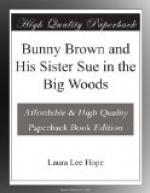“Huh! Indian no want to make little girl’s toy bad,” said the Indian handing it back. “Great toy, much. Very good to have.”
“What are you doing so far away from your camp?” asked Bunny. “Have you some bows and arrows to sell?”
“No got to sell to-day. Indian come to hunt lost cow.”
“Have you lost a cow?” asked Bunny and Sue together.
“Yes. Maybe you see him. He got two horns funny twisted—so”; and Eagle Feather picked up a crooked branch, like a fork or crotch, both parts of which were gnarled and twisted. “Horns like him?”
“Yes, just like that,” said Bunny. “The cow came to our tent in the night and we thought it was an elephant. Was it your cow? We thought it belonged to the white hermit who sold us milk last night.”
“No, two-crooked-horn cow belong Eagle Feather. Where you see him?”
Bunny and Sue told of Uncle Tad having tied the cow in the night and of her having broken loose.
“But maybe we can see which way she went by her hoof-prints in the mud,” said Bunny. “Come on, Eagle Feather. You saved my train from going into the lake where maybe I couldn’t get it up, so we’ll help you find your lost cow.”
CHAPTER VII
THE MISSING TRAIN
For a moment Eagle Feather, the Indian, stood looking at the two children, and yet not so much at them as at their two toys—the electrical train, and at the Teddy Bear with the queer electric eyes. It was hard to say of which the Indian was most fond.
“You ought to see my train run on the track!” exclaimed Bunny, as he shook some drops of water off the cars and engine. “I guess I’ll have to put oil on it now to keep it from getting rusty, as Uncle Tad does when I leave his tools out all night.”
“And you ought to see my doll at night!” added Sue. “Her eyes shine like anything, and once, after I got to bed, and wanted a drink of water that was on a chair near my bed, I just lighted Sallie Malinda’s eyes, and I found the drink without calling mother.”
“Huh! Heap big medicine—both of um!” grunted the Indian.
Eagle Feather was one of the oldest of the tribe of Onondagas who lived on the reservation, and though he usually spoke fairly good English, sometimes he talked as his grandfather had done when he was a boy and the early settlers first had to do with the Indians.
And when Eagle Feather called the children’s toys “heap big medicine,” he did not mean exactly the kind of medicine you have to take when you are sick.
The Indians have two kinds of medicine, as they call it. One is made of the roots and barks of trees, berries and bushes which they take, and some of which we still use, like witch hazel and sassafras. But they also have another kind of medicine, which is like what might be called a charm; as some pretty stone, a feather, a bone or two, or anything they might have picked up in the woods as it took their fancy. These things they wear around their necks or arms and think they keep away sickness and bad luck.




